How to properly drain your washing machine: a step-by-step guide and valuable tips
It is difficult to overestimate the role of washers in everyday life. Units unfamiliar with fatigue diligently perform part of the routine duties for the owners. Unfortunately, their mechanisms are characterized by periodic failures. Therefore, it is better to figure out in advance how to drain the water from the washing machine, so that in the event of a breakdown, know what to do.
We will talk about how to empty the washing machine tank if the programmed duty cycle is not completed. In our article, we describe all acceptable methods that have been tested in practice. Our recommendations will help to properly prepare the equipment for the restoration of performance.
The content of the article:
When does the need arise to drain water?
Regardless of the brand of the washing machine, its technical complexity and type of load, the reasons for draining water from the working tank are absolutely identical. If you exaggerate the situation, you can describe it as an interrupted cycle that did not end with the programmed drainage of water through the drain hose to the sewer, or a refusal to spin.
The reasons why the machine stops draining water are conditionally divided into the following groups:
- Blockages of internal nodes and channels. A case common enough for washing equipment due to the standard separation of fibers, loose stitches, decaying and "dusting" of the old fabric, the ingress of fine litter and foreign objects into the working bodies of the equipment.
- Blocking of output channels. The reasons are similar to the above assumptions. However, in this case, the “traffic jams” that interfere with the water outlet are not related to the washing mechanism. They are confined to the external drain hose and to the adjacent parts of the sewage system.
- Technical issues. This category includes an extensive list of minor irregularities and serious damage.Everything can happen, from the burnout of the pump winding to the drainage system to the appearance of defects in the transmitting command of the device.
There is another reason that has nothing to do with blockages or breakdowns - this is our inattention. It is possible that the mode was simply chosen incorrectly. Suppose, because of forgetfulness, they did not switch the “gentle rinse” function after the previous session. If so, then just stop and restart the machine.
A complex technical violation is not worth fighting with your own hands. Moreover, certified service centers that oversee products of certain brands often after independent intervention generally refuse to carry out repairs.
However, before deciding to disassemble the machine, you need to find out if the clogged hose or sewer siphon was the reason for the refusal.
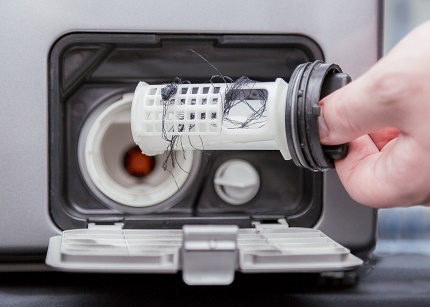
It often happens that identifying the causes of failure of washing equipment to drain water in normal mode is accompanied by its simultaneous elimination. It is clear that this happens when the standard blockage is removed.
Filter clogs located in front of the drain pump, and clogging of the nozzles installed next to the pump can be handled independently, without resorting to the expensive services of repairmen.

Options for draining water from the machine
The need to drain water from the washing tub arises both in the machines that completed the programmed work, and in those who interrupted the cycle due to a breakdown.
Procedure for locking the door
If not all the stages laid down by the control unit have been completed, then the hatches of the front models will still be blocked for 5 to 10 minutes. No need to pull the hatch holder and in vain panic. It will easily open after a period agreed upon by the manufacturer of the unit.
If, however, the hatch does not open after the time agreed by the manufacturer, then proceed as described in recommended by us instructions. We advise you to read a very useful article, which describes the process in detail.
Better ahead of time to cover the floor around the machine with old bedding, towels or similar hygroscopic things that perfectly and quickly absorb water, and are also able to hold it for a long time. In case of jamming, emergency unlocking tools are used.
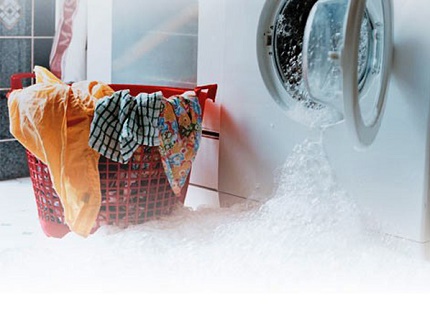
If after opening the hatch in the drum there is water that can be scooped out with a plastic bucket or measuring cup, it is wiser to do just that. Having got rid of part of the water in this way, we ourselves will greatly simplify the task.
Almost all the water can be scooped out of the top-loading washers, then the residues can be drained through a hose. The approach to the front units is somewhat different. You can easily draw water from the drum if it is relatively small in it, i.e. the level does not reach the upper edge of the lower edge of the rubber cuff.
If there is clearly more water in the front technology than would be desirable for safe scooping, it is better not to risk it and not to open the hatch right away.
It is advisable, without opening the frontal machine, to slightly move it away from the rear wall. Then you need to slightly “tilt” it back and carefully lean it against the wall with the top edge. From such a movement, water-containing containers will be spilled on the floor much less.

It is important to remember that all actions with the washing machine, regardless of their degree of complexity, must be performed by turning off the equipment and unplugging the plug. It is also necessary to shut off the supply of tap water. Next, we will analyze the options for draining the water from the washing tank.
Method # 1 - Using an Emergency Hose
The possibility of the described situations is provided by a number of manufacturers. For example, in the line Samsung washing machine and Bosch technicians there are models located next to washing filter emergency hose, through which the tank filled with water is easily and simply if necessary emptied.
This device is located next to the drain system filter. To access it, just open the decorative hatch located at the bottom of the front panel of the machine. It disguises and protects the nodes necessary for servicing.
To discharge:
- We remove the emergency hose from the nicheintended for its laying in an idle state.
- Install a flat container directly under the hatch or as close as possible to him.
- Remove the cap from the edge of the hose, put it in a container and wait until all the water from the washing tub is completely merged.
If this hose also clogs during the drain, it is better to carefully clean it immediately, without disconnecting it from the machine.
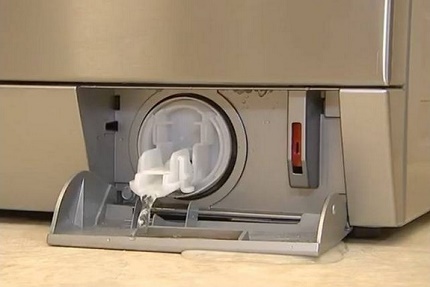
Method # 2 - drain through a hole with a filter
This method, of course, refers to the most time-consuming and "dirty." The drain hole to which the drainage hose is attached is located behind the decorative hatch described in the previous case. A filter is installed in front of the hose inside the structure, which, according to the rules of operation, needs to be cleaned periodically.
In older models, washing machines, for example, in Indesit brand models, the drain hole with the filter inserted above it is quite low, it’s quite difficult to substitute even an almost flat container under it.
A plate with low sides, but since it will fill up extremely quickly, the hole will often have to be blocked, tightly twisting the device with a filter grill. Then open again and close again - this is a long time, but the drain is made fully and efficiently.
The filter drain algorithm is as follows:
- Open the service cover - a small hatch located at the bottom of the machine.
- Carefully unscrew the plastic fixture with filter grill, setting it in motion counterclockwise with the screw in the design. First we unscrew quite a bit, about 10 °. If it does not give in, then we will help him with a screwdriver inserted into the groove on the screw.
- Drain the water. By loosening the tight connection in the area of the drain unit with the filter, we achieve a stream that is convenient for collecting water. Filling the stored plate or cuvette, we screw the filter screw back so that the water does not flow.
So we act until the machine is completely free of water. After completing the drain, remove the device with a filter grill and clean it.
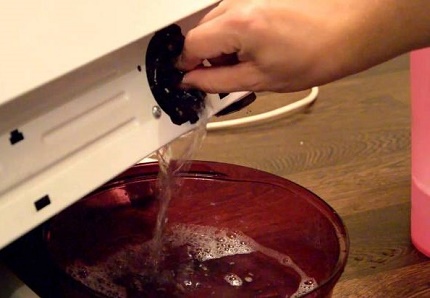
By the way, it is not the cleaned filter that is a characteristic reason for the machine to stop without completing the operations set by the task. With frequent repetition, this leads to an excess of the load on the drain pump and to its almost inevitable failure.
Method # 3 - using a drain hose
This is the easiest and most efficient way to free the washing tub from water. True, it is suitable if the filter of the drainage system and the drainage hose are not clogged. Most often, you have to do this if the pump breaks, pushing water into the sewer.
According to the described method, the drain hose attached to the rear panel of the unit must be unscrewed from the hole intended for it and simply laid on the floor previously covered with rags, i.e. arrange at the lowest level.

If water comes out of the hose, immediately put it in a container nearby. Everything that spilled by should be cleaned immediately, without waiting for the arrival of indignant neighbors from the apartment below you. After the machine is free of water, it is necessary to clean the drain hose filter and screw it back to the hole on the back of the device.
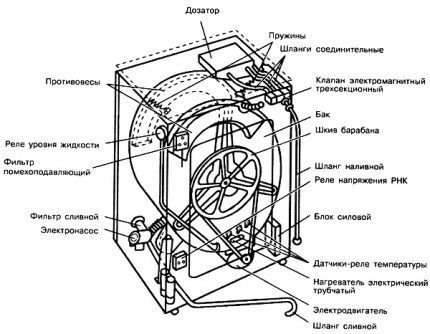
Note that the method described in this example is not suitable for all machines. For a number of modifications from Siemens and from Bosch, a part of the drain channel is arranged in the form of a loop located inside the housing.
Thanks to the indicated constructive solution, spontaneous discharge of water does not occur during operation, but it is also impossible to empty the tank using the described method.
In order not to waste time, it is better to look in advance at the passport and technical documentation attached to home appliances. If the indicated design feature has a place to be, you must choose another method for draining.
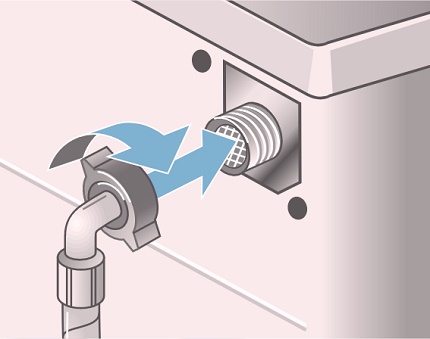
Method # 4 - discharge through a drain pipe
In the implementation of the forced option of draining through the pipe, radical measures will be required with the analysis of the machine.
To resort to this method without obvious reasons is not worth it. It is suitable if all of the above methods did not end with the expected result. In addition, its implementation requires the application of male hands.
How to determine what the washing machine needs to be disassembled? A typical sign is the complete absence of water in the drain hole after removing a filtering device with a mesh from it. This means that the internal channel is blocked, which diverts water to the drain hole.

Sequence of actions in case of discharge through a branch pipe:
- Remove the back or front panel of the washerhaving previously unscrewed the fasteners and laid it in a suitable box or plastic cup.
- We find a drain pipe. It is located under the tank, inside which the drum rotates.
- Substitute any flat capacity under the site under the pipe, the area around is covered with rags for instant collection of spilled water.
- We disconnect a collarwith which the pipe is connected to the pump of the drainage system, we dismantle the pipe, after which water should flood. We quickly collect it and pour it into the sewer.
- We clean the nozzle and the adjacent channel is just a finger, a pencil or a similar object.
Having finished draining and cleaning the nozzle, we install the machine parts in their proper place, we twist them with effort, not forgetting that everything should be tightly connected to the maximum.
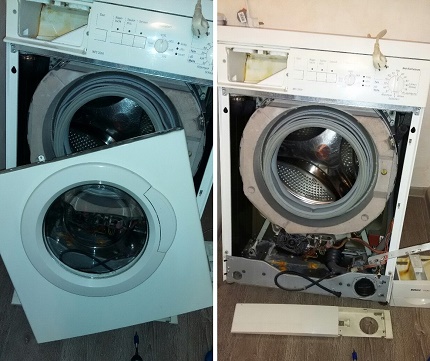
If during the execution of the scraper it is found that the litter and fibers are clogged drain pump, carefully unscrew the pump cover and clean it of impurities that interfere with the work.
At the same time, we clean the thread of the drain pump and the inner surface of the housing. Check how the impeller rotates. If it’s free, we assemble the system in the reverse order, if rotation is difficult, we clean the connection unit of the impeller with the motor of the device.
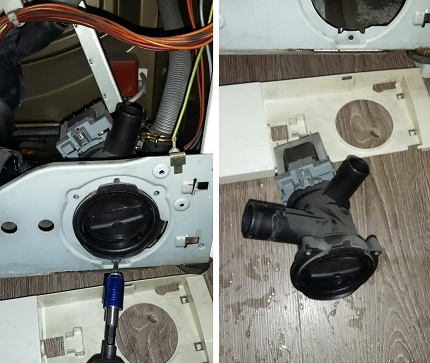
Recommendations to hostesses and home masters
An impressive list of breakdowns and machine stops without completing the program can be elementarily prevented by observing the simplest operating rules:
- Remove all contents from pockets before loading items into the drum.. Coins, paper clips, earrings, rings, small luggage keys and similar metal objects are especially harmful to the unit.
- Check the strength of sewing buttons and zippers. Before immersing clothes prepared for washing, locks-snakes and buttons must be fastened.
- Brush dust and sand under the lapels and pockets with a brush..
- Remove hooks before washing curtainsby which they are connected to the cornice wheels.
Do not forget that the washing unit is a complex technical device that requires a careful attitude.

We regularly clean the drain system filter at the intervals specified by the manufacturer.
If we load worn laundry in order, clean the filter after each wash.
Conclusions and useful video on the topic
Video # 1. Draining water using an emergency hose and primitive filter cleaning:
Video # 2. Demonstration of the process of removing water from the washing tank of the activator machine:
Video # 3. Details on the technology of draining water from the machine:
Strict observance of operating rules in most cases avoids situations requiring forced draining of the water tank. However, no one is completely safe from them..
Therefore, it is better to get information in advance about all the possible methods used by independent home masters.
Want to talk about how the water was drained from the washer tank after a malfunction? Do you have useful information on the topic of the article, is there a desire to share only with you a known method? Please write comments in the block below, ask questions and post photos.

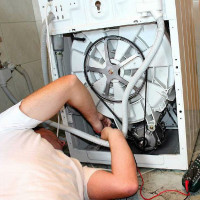 How to repair the shock absorbers of a washing machine: a step-by-step guide
How to repair the shock absorbers of a washing machine: a step-by-step guide  Ariston Washing Machine Errors: Decoding DTCs + Repair Tips
Ariston Washing Machine Errors: Decoding DTCs + Repair Tips 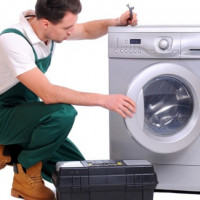 Installing the washing machine: step-by-step installation instructions + professional tips
Installing the washing machine: step-by-step installation instructions + professional tips  DIY Samsung washing machine repair: analysis of popular breakdowns and repair tips
DIY Samsung washing machine repair: analysis of popular breakdowns and repair tips  Filter for a washing machine: overview of types, selection criteria + installation features
Filter for a washing machine: overview of types, selection criteria + installation features 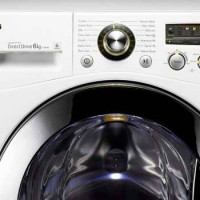 LG Washing Machine Errors: Popular Trouble Codes and Repair Instructions
LG Washing Machine Errors: Popular Trouble Codes and Repair Instructions  How much does it cost to connect gas to a private house: the price of organizing gas supply
How much does it cost to connect gas to a private house: the price of organizing gas supply  The best washing machines with dryer: model rating and customer tips
The best washing machines with dryer: model rating and customer tips  What is the color temperature of light and the nuances of choosing the temperature of the lamps to suit your needs
What is the color temperature of light and the nuances of choosing the temperature of the lamps to suit your needs  Replacement of a geyser in an apartment: replacement paperwork + basic norms and requirements
Replacement of a geyser in an apartment: replacement paperwork + basic norms and requirements
It was very interesting to read. I often have to drain water. I put children's jackets or pillows, or blankets, and when the time comes for wringing, my machine refuses to work and gives an error. We have to open the door and drain all the water. Tell me, maybe what am I doing wrong? In theory, the machine is designed to wash such things.
I can only assume that your machine is “on strike” due to incorrect centering of the weight of what is loaded into the machine. I had this: I was washing a pillow, and the machine tried to spin it ten times, it shook like horror, but still it stopped and started the process anew. The problem was solved when I put on another duvet cover. Apparently, then the weight settled evenly, and the machine was able to wring.
There can be two reasons for stopping in your case - overload and imbalance of loaded things. Try washing clothes in parts, or evenly distribute the laundry in the drum. And for the future - indicate the error code that appears on the display.
Hello. Arisha, it is unfortunate that you did not specify the model of your washing machine and error code. But we will try to find a reason with you together. Possible reasons, in my opinion, are:
1. Violation of centering of linen.
2. There are problems with the drain pump. Checking this is very simple, you already know how to drain water, try to get your finger into the drain hole, if it clogged.
3. Faulty level sensor.
4. Problems with the control module.
However, all these options can already be ruled out, since you wrote that they are observed when washing “heavy” things, without mentioning about light ones. Therefore, as already advised below, check the weight of things before loading, so that it matches the capabilities of the washing machine. Most likely, the problem is this, but I still have a very dubious one, but the option is that you spin manually on such a program.
Write a model of the machine, an error code and tell us, did she erase it without complaints in this program before?